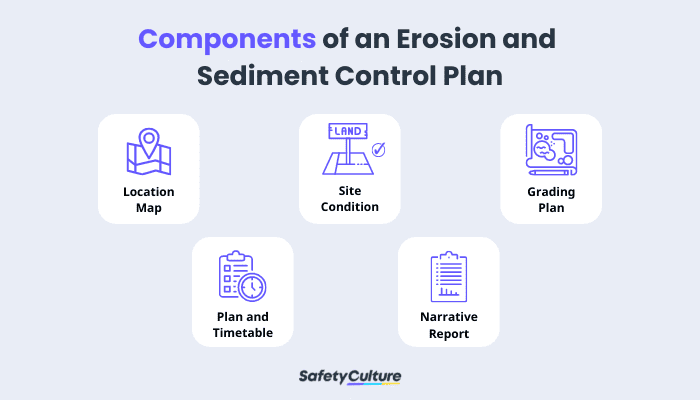What is an Erosion and Sediment Control Plan?
An erosion and sediment control plan is a strategy for specific sites that need to identify erosion risks and determine controls to be put in place in order to reduce the amount of erosion and sedimentation that can occur as a result of a project.
There are construction activities that expose the soil, making it vulnerable to wind and water which then causes erosion and sedimentation. Eroded soil can cause a range of problems, such as a reduction in water quality and even affecting crop growth.
Erosion and sediment control plans are designed to address any concerns regarding the negative impacts of erosion and sedimentation and what should be the appropriate actions to address these concerns and reduce the risks.
What is Erosion and Sediment Control?
Erosion, simply put, is the ground wearing down. Erosion occurs when the ground shifts due to wind and water, among other reasons. Building structures, the occurrence of some natural events, and the implementation of land management techniques can all lead to erosion. This can cause the soil to lose much of its natural water, affecting the crops. Erosion also exposes the subsoil, a layer of earth that typically doesn’t have the same qualities as the topsoil, which can have a significant effect on the environment.
Since man-made structures and land management techniques can contribute to erosion, organizations and those working on the land need to implement measures to reduce erosion and sedimentation. This is what erosion and sediment control is and what it’s for.
Simply put, erosion and sediment control is the process of preventing erosion and reducing the movement of sediment in the ground. This drastically prevents erosion and sedimentation from affecting the environment and causing significant consequences.
There are many ways to control sedimentation and erosion, and the process is necessary when working on specific sites. And to ensure that an organization takes the appropriate measures to control erosion and sedimentation, many localities require a comprehensive erosion and sediment control plan before allowing the project to commence.
When Do Organizations Need an Erosion and Sediment Control Plan?
The types of organizations and projects that require an erosion and sediment control plan may vary from locality to locality. That said, it’s important for any organization to have adequate controls for erosion and sedimentation before starting a project, even if it’s not a government requirement to ensure the safety and sustainability of the project.
Certain areas require organizations and individuals to practice erosion and sedimentation control without requiring a plan. However, many large construction projects that cause a disturbance to the land will need an erosion or sediment control plan before they can continue on with construction.
Additionally, any activity or project that will move or disturb the ground requires an erosion and sediment control plan. Since erosion and sedimentation can significantly affect the environment and the livelihood of people in the area, it’s crucial that there are measures in place to reduce their effect.
Why is It Necessary?
Erosion is a natural process that can occur over time. Usually, erosion is caused by water and wind, which wears down the earth. However, human activities may also cause erosion. And when left unchecked, erosion can have a significant impact on businesses, society, and the environment as a whole.
A good example of this is the crops. The crops that humans grow to sustain themselves require specific soil conditions. This doesn’t just mean the chemical composition of the soil, but it also means the water levels underground. When there’s a lot of erosion and sedimentation, the chemical properties and the water levels undergo change. This can have an effect on crop yield and crop growth, which in turn has a massive effect on society.
Aside from being a requirement for certain projects and structures, erosion and sediment control plans are necessary to keep the environment safe. Having a proper erosion and sediment control plan indicates that the organization did the research on the potential effects of their project and ensured that it wouldn’t significantly harm the environment and soil conditions.
Digitize the way you Work
Empower your team with SafetyCulture to perform checks, train staff, report issues, and automate tasks with our digital platform.
Get Started for FreeComponents
Depending on the location of a project and its scale, an erosion and sediment control plan may require various components. However, these are some of the most common components found in an erosion and sediment control plan.

Location Map
A detailed location map of the project site is one of the key components of an erosion and sediment control plan. These maps should include the site’s proximity to bodies of water, roads, access points, and more.
Current Site Conditions
This component includes a soil map and the current soil conditions of the project site. The site conditions should display all the gradings and features of a site before a project begins.
Grading Plan
This part of the erosion and sediment control plan contains the proposed finished contour of the land. This should also include a timetable that contains each phase of the project and its effect on the soil. The grading plan also includes the control measures during each phase to reduce the amount of exposed soil.
Plan and Timetable
This part of the plan contains the actual erosion and sediment control measures that will be in place. The grading plan should be the foundation of this final strategy. This may also be combined with the grading plan for a more comprehensive strategy.
Narrative Report
A comprehensive erosion and sediment control plan requires a narrative report of each project and phase, along with the control measures in place. This should give anyone reading the report a full idea of a specific project’s erosion and sediment control plan.
FAQs About Erosion and Sediment Control Plans
Water is the major cause of erosion. Rainwater, rivers, oceans, and floods can all contribute to erosion. Additionally, implementing man-made structures and land management projects may also contribute to erosion which is why erosion and sediment control plans are necessary.
Some of the methods used to control erosion include planting vegetation, reforestation, building silt fencing, plastic sheeting, creating a drainage system for the water, and building terraces.
To write an erosion and sediment control plan, it’s crucial to get as much information on the project site and its current conditions. From there, the team needs to determine the potential erosion risks and consequences of the project as well as the controls meant to mitigate the risks. To make it easier to create the plan, you can also use an erosion and sediment control plan template to serve as a foundation.
Organizations must submit erosion and sediment control plans to the relevant government agency. This can vary depending on location, however, many localities require organizations to submit their erosion control plans to the planning and building department of their county.




